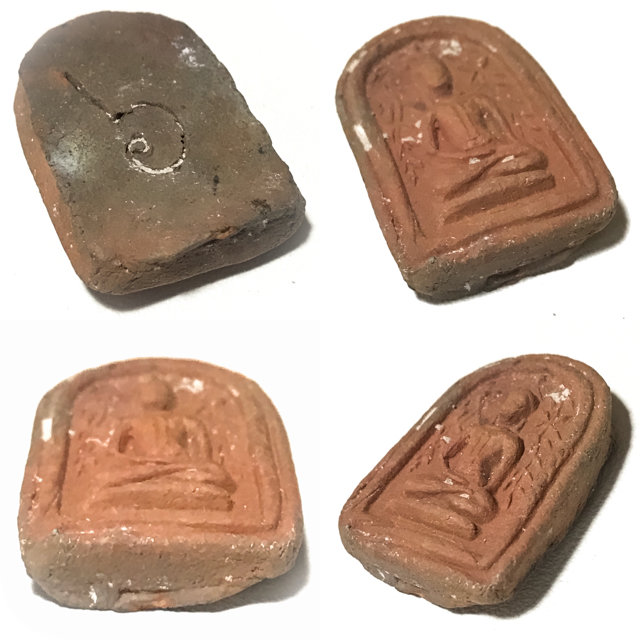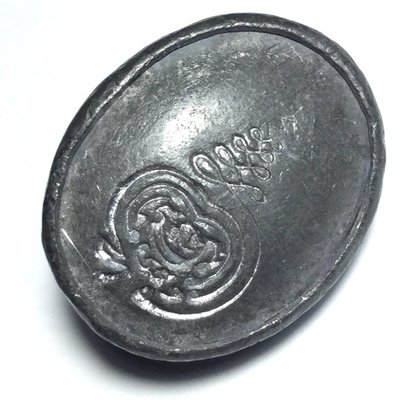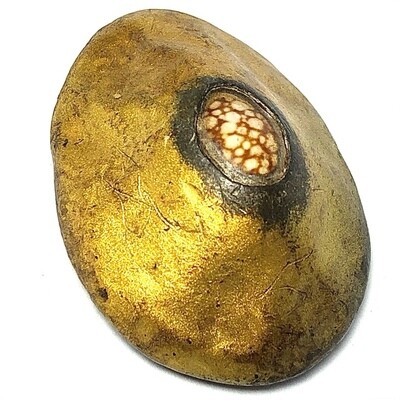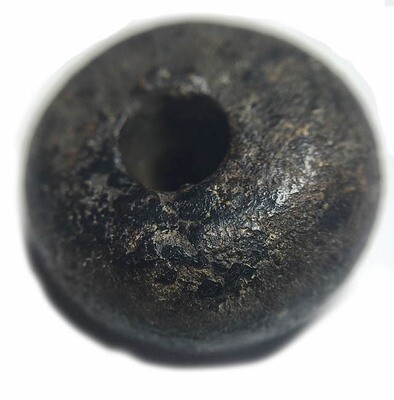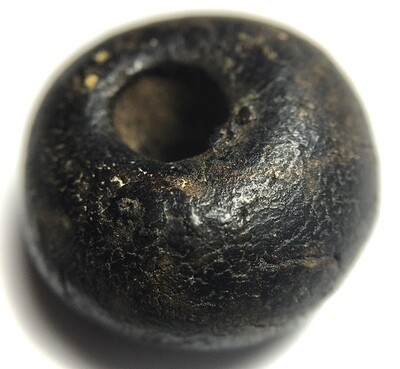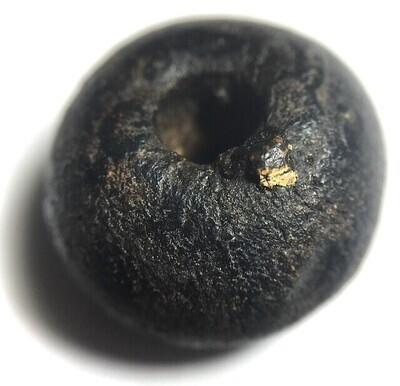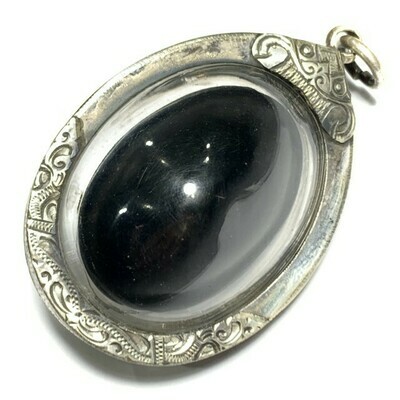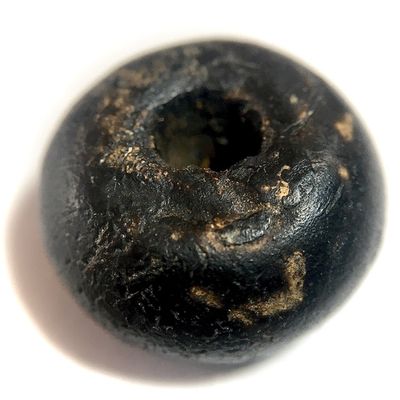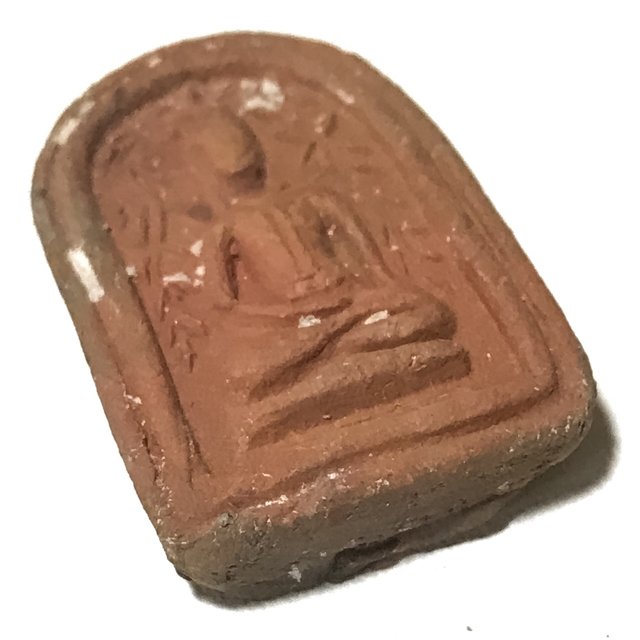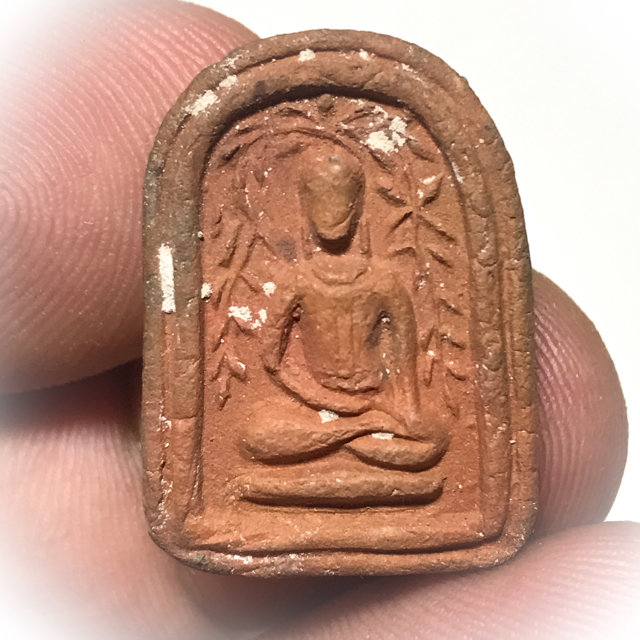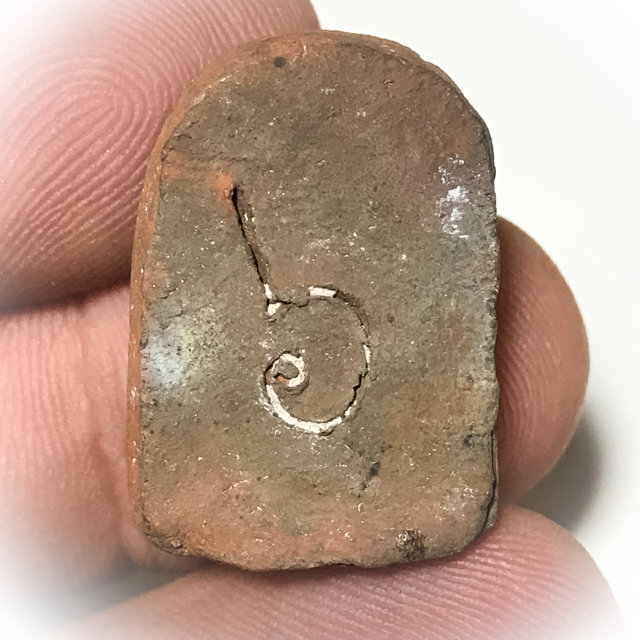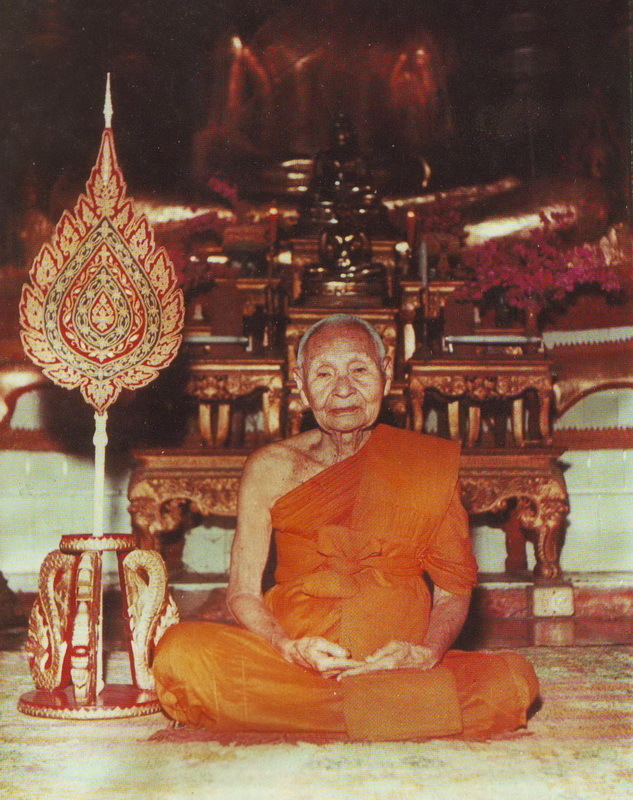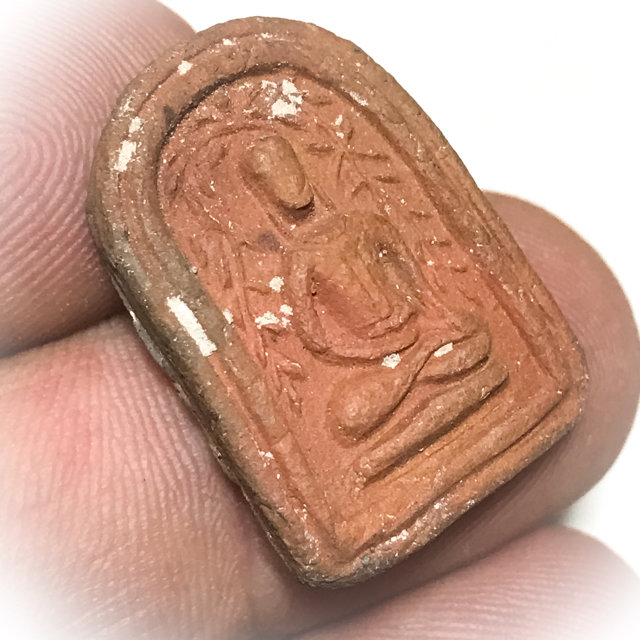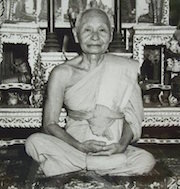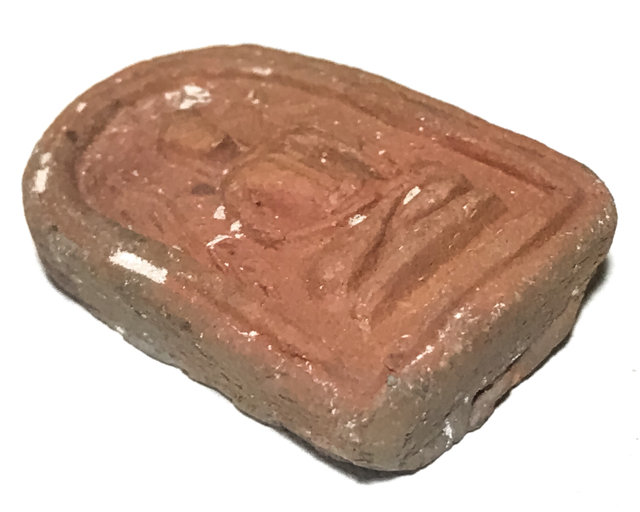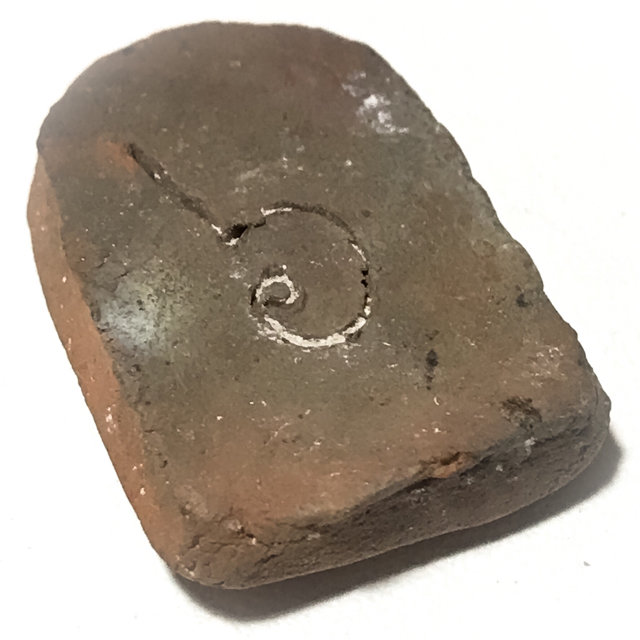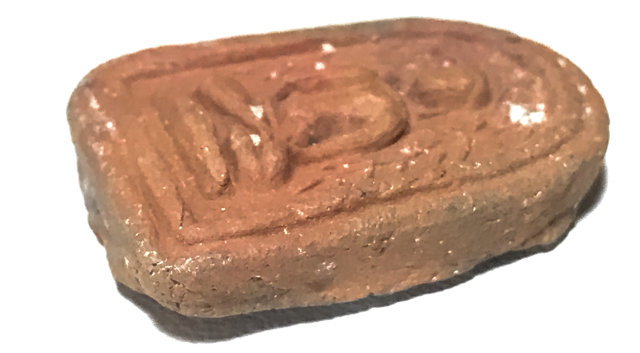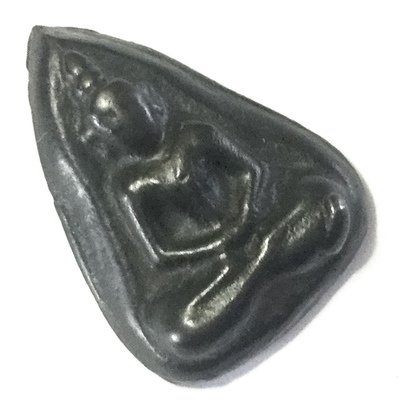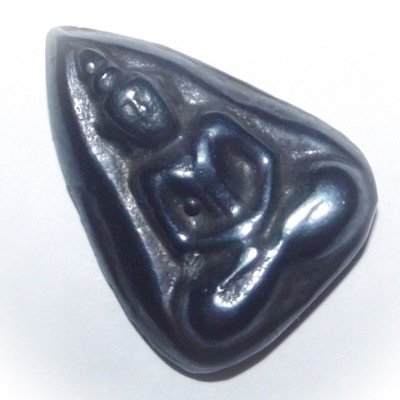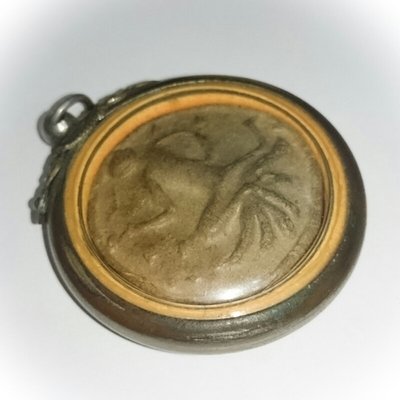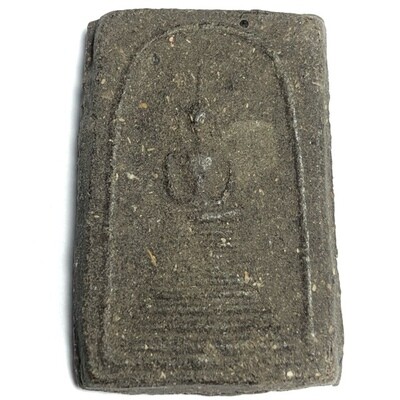Presenting a tiny but powerful and rare classic amulet from one of the Great Khao Or Masters of the 20th Century, Rian Glom Lek Hlang Chedi 2505 BE Nuea Tong Daeng Miniature Guru Monk Coin Por Tan Klai Wajasit
This Sacred amulet of the Great Khao Or Master of Nakorn Sri Tammarat, Master of Wat San Khan and Wat Pratat Noi, is a very rare amulet from Por Tan Klai’s 2505 BE Blessing Ceremony Edition, and is considered a ‘Jaek mae Krua’ type amulet (meaning ‘give to the kitchen maids and temple helpers’), which is suitable not only for men, but due to its miniature size, a perfect amulet for ladies or children to wear.

Rian Glom Lek 2505 BE Por Tan Klai Wajasit Wat Suan Khan
The 2505 BE edition of amulets of Por Tan Klai, is a highly preferred edition, which saw his famous ‘Rian Glom’ round Monk coin amulet with Chakra released, The Rian Glom Lek Hlang Chedi, and the Roop Tai Por Tan Klai Guru Monk Blesséd Photographamulets such as look om chan hmak and ya sen tobacco balls, and sacred powder amulets of various models.
A very rare and highly prized amulet for the devotees of Por Tan Klai to associate with his image and pray to him with a blessed image of the Guru, and the Chedi Relic Stupa on rear face for Buddhanussati and Marananussati. A powerful and Sacred amulet which has passed through the hands of the Guru and been blessed by him.
Por Tan Klai was one of the Top Guru Master Monks of the Last Century, and is considered one of the Four Great Masters of the Previous Generation of Lineage Masters of the Khao Or Southern Sorcery Lineage.
Kata Bucha Por Tan Klai
Pra Pim Sadung Glab Nuea Din Phao Jarn Mer - Luang Phu Perm Wat Klang Bang Gaew
Ancient Amulet presents a Sacred Clay amulet, The Pra Leb Mer Pim Siarn Lone Sadung Glab in baked earthen Muan Sarn Sacred Powder Clay, with hand inscription on rear face (Thai ๖) . A rare and classic amulet from four generations ago, from the Great Master Monk of Olden Days, Luang Phu Perm (2429 - 2526 BE) of Wat Klang Bang Gaew, in Nakorn Pathom. This exhibit is especially sacred and desirable for the hand made inscription of Numerology Spell on the rear face. The amulet has Kraap Kru white cement adhering to it from the Kru Burial Chamber, adding even more character and prestige to this pristine detailed exhibit.
Luang Phu Perm always preserved the Dtamra of the Pantheon of Wat Klang Bang Gaew amulets, furst famously revered for Luang Phu Bun, and then Luang Phu Perm The amulet features the image of a bald headed (bald headed), long eared (Hoo Yaan) Buddha, seated under the Bodhi Tree with the leaves cascading down around him (Prok Po with downward pointing leaves)
The Pim was molded from a block press taken from the original Pra Pim Siarn Lone Sadfung Glab of Luang Phu Bun, to preserve the Wicha both in its design featurtes, as well as in the Muan Sarn Sacred Powders used in their making, which will contain a certain quantity of Pong Ya Wasana Jinda Manee.
Below; Pra Pim Leb Mer Siarn Lone sadung Glab - Luang Phu Bun - Wat Klang Bang Gaew
An olden days classic, of immense rarity, from the second of the four Great Masters of the Wicha Luang Phu Bun Lineage, in sacred earthen clay, with Ya Wasana Jinda Manee Powders added. The amulets of Luang Phu Perm enjoy the same level of appreciation as those of his predecessor and Kroo Ba Ajarn, Luang Phu Bun, and are amongst the most highly sought after, and difficult to find of the Masters of this Great Temple with so many consecutive Generations of Top Master Monks.
Luang Phu Perm was the closest of all monks to Luang Phu Bun himself, being under his tutelage and in his service daily since his early ordination as a Samanera at the age of 8 years old. Luang Phu Perm hence remained also pure of the ways of the world, being a Bhikkhu since childhood, and learning the Wicha of Luang Phu Bun since a very young age.
Luang Por Perm followed the World Famous Dtamra Wicha Saiyasart the Great Luang Phu Bun, of Wat Klang Bang Gaew, inheriting all of the Wicha from Luang Phu Bun, and Mastery of the fomulas of the special and famously powerful Muan Sarn Sacred Powders of Ya Wasana Jinda Manee, and Ya Khamin Sek. These two powders, along with a large number of classic Buddhist Amulet models, and of course the Bia Gae Cowrie shell amulet, are special Wicha, for which the temple of Wat Klang Bang Gaew, and the lineage of the four last abbots of the temple are all world famous for.
The Pong Ya Wasana Jinda Manee of Luang Phu Bun has become almost mythological in its fame for the powers it contains, and is one of the main Muan Sarn Sacred Powder substances used in the amulets of all Masters who came before and after Luang Phu Bun at the Temple of Wat Klang Bang Gaew, beginning with Luang Por Bun, Luang Por Perm, Ajarn Bai, Luang Por Juea, and onwards to the present Abbot, Luang Por Kong (Sanya).
The Wicha Pong Ya Wasana Jinda Manee is considered to be synonymous with the temple of Wat Klang Bang Gaew, and it is common knowledge that this is an inheritance from the great Luang Phu Bun. The Pong Ya Wasana Jinda Manee Muan Sarn Powders of Luang Phu Bun (also known as 'Pra Ya Horm') is a very aromatic Sacred Powder, which uses of course the famous 'Ya Wasana.
The word 'Wasana' (meaning Lucky Fortunes), along with Pong Khmain Sek (Enchanted Cumin) is the most famous Muan Sarn of Luang Phu Bun, and has become his Legendary 'Dtamra' (Traditonal Legend of Inheritance Wicha). The Wicha of Ya Wasana Jinda Manee was developed by Luang Phu from an Ancient Teaching through his Kroo Ba Ajarn, and has since his making the Muan Sarn famously powerful, has been inherited as a Wicha of Muan Sarn powder making for the amulets of the Wat Klang Bang Gaew lineage
The Legendary Wicha of Wat Klang Bang Gaew masters, began the legendary lineage sorcery with the Great Luang Phu Bun, followed by Luang Phu Perm, who succeeded Luang Phu Bun as new abbot after his passing, in 2489 BE.
Luang Phu Perm remained abbot of the temple until his passing in the year 2526 BE, and was succeeded by Ajarn Bai, who was then succeeded by the next abbot in this lineage Wicha of Wat Klang Bang Gaew, Luang Phu Juea Bpiyasilo. Luang Phu Juea also passed away some years ago, and has been succeeded by the 4th abbot, Luang Por Sanya (Kong).
Luang Phu Perm and indeed all of the abbots of Wat Klang Bang Gaew, were the most famous Masters for the Wicha Bia Gae Cowrie Shell animist charm, whgich are legendary and extremely rare Pra Niyom category Talismanic amulets, most of which already reside in personal shrines, with their owners and wearers, and in High End Auction Rooms, fetching elevated prices. Their magical power is the major factor in what has brought the amulets of the Wat Klang Bang Gaew lineage all fall into the high end Pra Niyom Category, because of the demand and rarity of their acquisition, and the belief in their magic power.
Wat Klang Bang Gaew is an Ancient Temple in Nakorn Pathom. It is home to a Lineage History of these 4 great Ordained Masters, 3 who have Passed On (Luang Phu Bun, Luang Por Perm & Luang Phu Juea), and the Current Master, Luang Por Kong (Sanya). Luang Por Sanya is proving to continue in the same Trajectory as his Predecessors, and has created a long History of Deeds and released a large Pantheon of Amulets in the Lineage tradition of his Mentors, Luang Phu Bun, Luang Por Perm and Luang Phu Juea.
The Wat Klang Bang Gaew Master Lineage is a fantastic choice for Hunters & Collectors of Fine Master Class Amulets. This is because the Amulets of this Temple, and its Masters, range from the present Day master Luang Por Kong (Sanya), back through Luang Phu Juea, Luang Por Perm, and on, to the Great Luang Phu Bun.
A powerful continued Lineage of Masters have brought Wat Klang Bang Gaew to the Forefront of both the Ancient and the Modern Amulet Scenes, stretching back to the times of Luang Phu Bun, through the Era of Luang Por Perm, and the Great Luang Phu Juea Bpiyasilo, to its present Abbot, Luang Phu Sanya (Kong).
Kata Aaratanaa Pra Krueang
Puttang Aaraatanaanang
Tammang Aaraatanaanang
Sangkang Aaraatanaanang
Puttang Prasittimae
Tammang Prasittimae
Sangkang Prasittimae
Chant this Kata 3 times whenever you are about to place the amulet neckchain over your head or put on the amulets, and also when you take them off. The Kata calls upon the power of the Buddha, Dhamma and Sangha to be with you and protect and Guide you.
